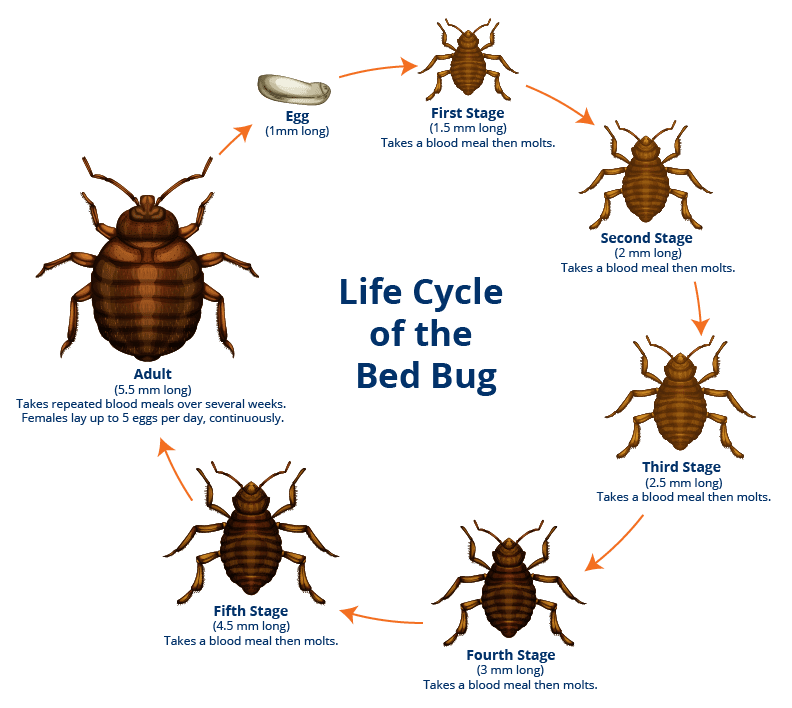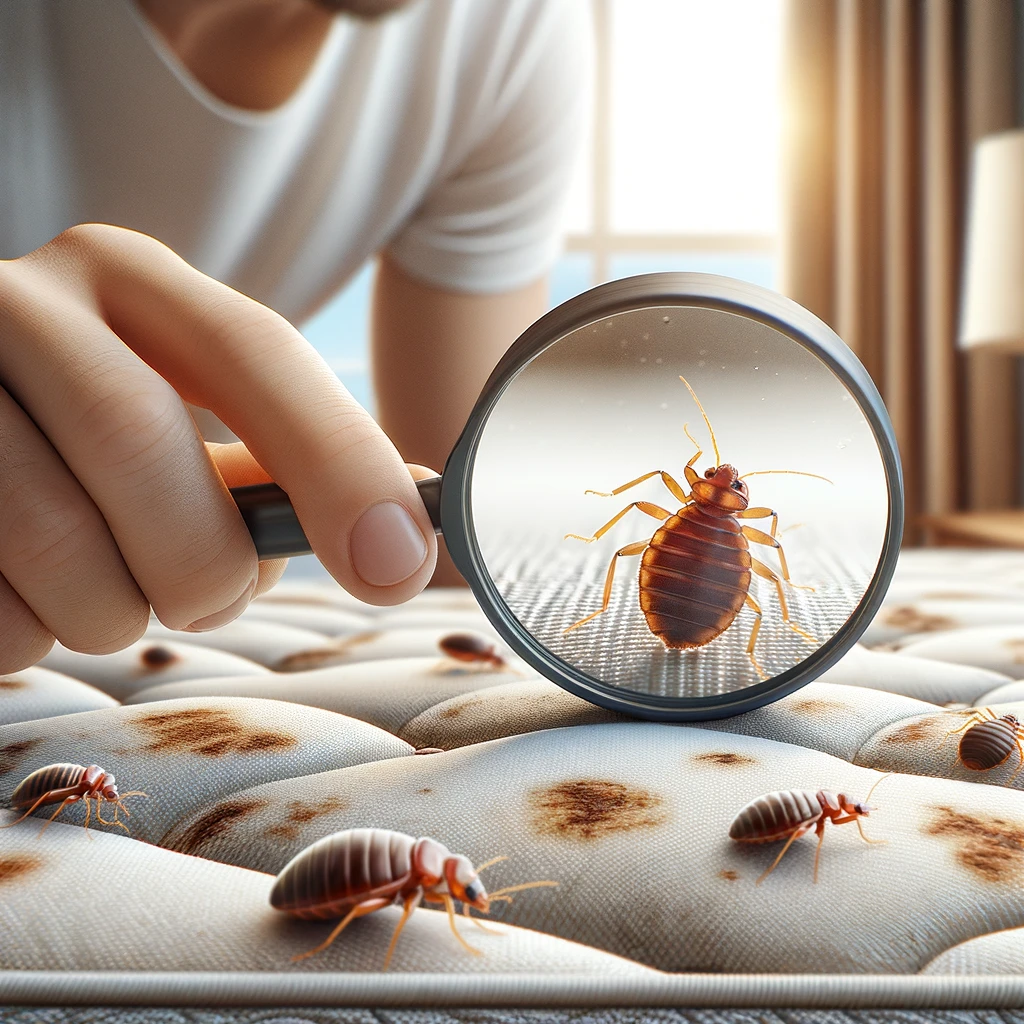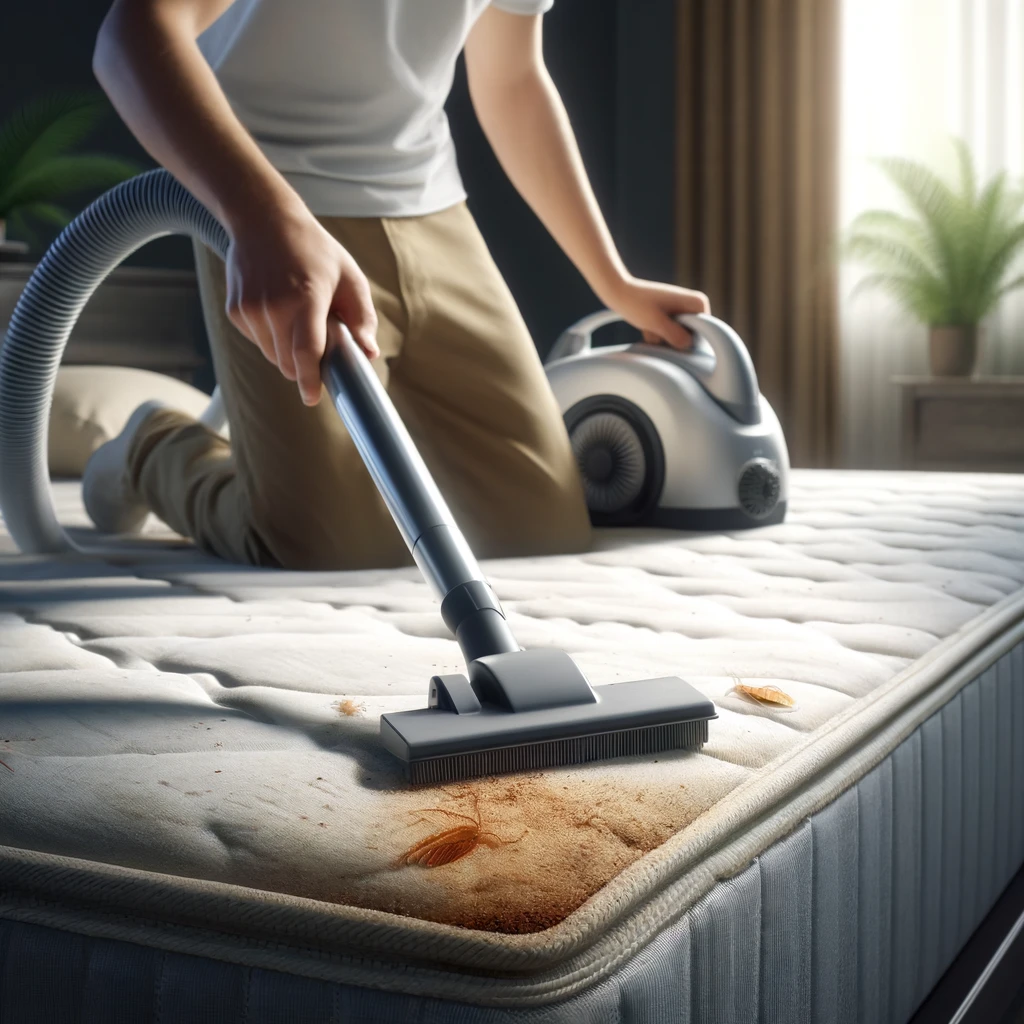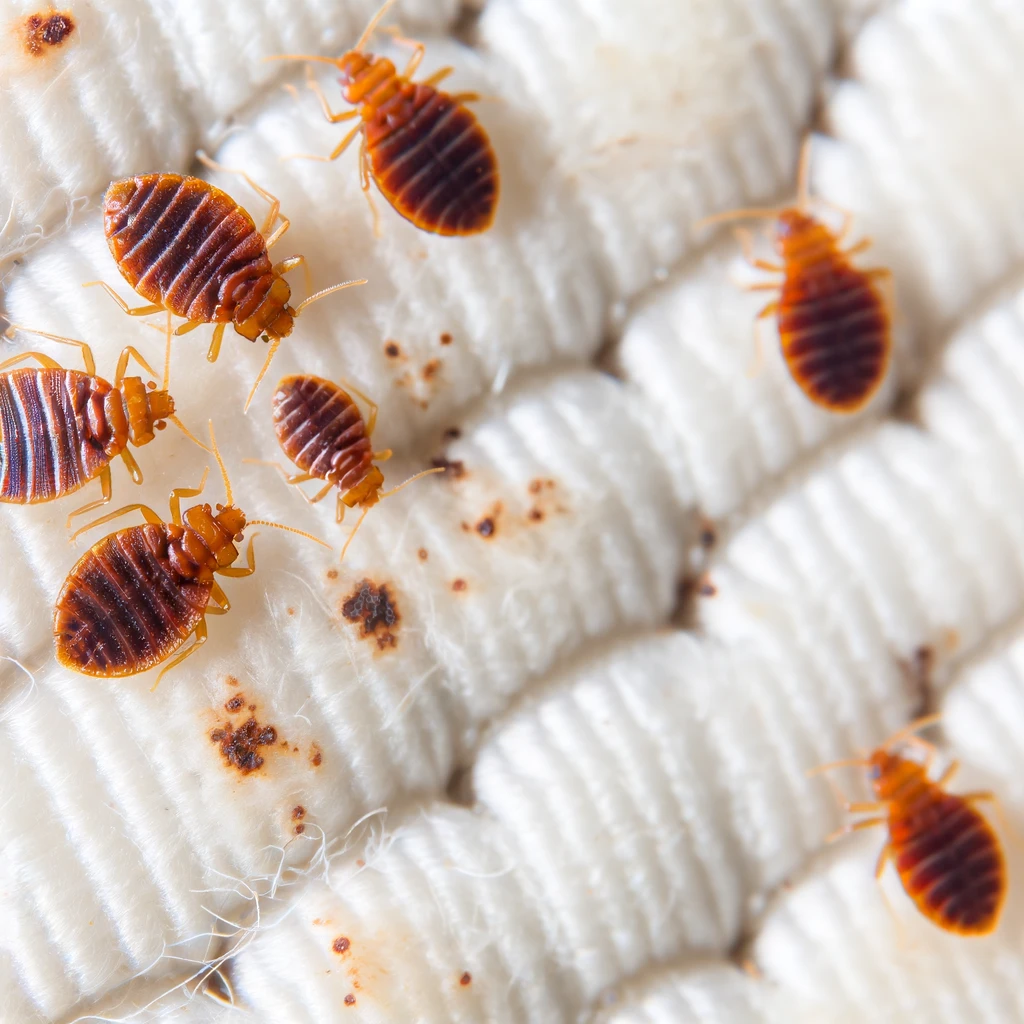What Are Bedbugs?
Now for those who don’t know about bedbugs, a bedbug is a small wingless insect that lives primarily on blood. Bedbugs don’t feed on dogs, cats, lizards or chickens. They feed on humans.
At birth, they are called nymphs and are both transparent and microscopic in size. Until they have their first blood meal, they don’t have any color. After that, they are typically brownish or blackish in color and Full grown they are about the size of an apple seed.
Bedbugs are typically nocturnal in nature which means they mostly come out at night to feed. They like to hide in any cracks or crevices they can find but usually conglomerate in around or near sleeping areas of humans, so they have easiest access to feeding.

Bedbugs are attracted to humans by a combination of carbon dioxide and body heat, which is mostly generated by human when we sleep. They typically like to feed just before dawn because that is when humans emanate the greatest amount of body heat and carbon dioxide. When they feed, they use their beak or mouth which is called a stylet and they pierce the skin and inject the victim with both an anesthetic and an anti-coagulant. The anesthetic is to numb the area so you don’t feel the bite, and the anti-coagulant is so they can avoid the blood clotting when they feed. They can feed up to three times session for up to five minutes, its called breakfast, lunch and dinner.
Now like any other insect bite, bedbugs affect different people in different ways. Some it doesn’t affect at all. 30% of all people have no visible showing of bites. Others can get severe allergic reactions, intense pain, intense and severe itchiness constant scratching swelling and rashes. It has been known to cause sleeplessness, anxiety and fear.
As far as where they come from or how you get them, they are known as hitchhikers, they can be introduced by people, animals belongings. It is virtually impossible determine what the origin of bedbug infestation is.
Do Bedbugs Only Live In Dirty Spaces?
Actually, the likelihood of getting bedbugs has nothing to do with cleanliness, even the CDC will tell you so.
They feed on blood. Human blood and once you got them, they can lay up to 500 eggs in their lifetime. They feed and breed, that’s all they do.
They hide in dark places, cracks and crevices of everything, electrical sockets, popcorn ceilings Baseboards mattresses furniture, electronics clothes, everything.
Once you get them, the potential is that all your personal property may get contaminated.
It only takes one female bedbug to make its way into a dwelling to create havoc.
Now bedbugs have been around forever, but during the from 1930 till around 1970 they used to use DDT, which all but eradicated the bedbugs in the USA but DDT proved to have serious side effects from the poison, so it was banned.

What Are The Physical Reactions To A Bedbug Bite?
Bed bug bites can cause various physical effects, which may vary depending on the individual’s sensitivity to the bites and the extent of the infestation. Common physical effects of bed bug bites include:
1. Redness and Swelling: Bed bug bites often result in red, swollen bumps on the skin. The affected area may appear inflamed and raised.
2. Itching: Bed bug bites are typically itchy, which can lead to discomfort and irritation. Some people may experience intense itching, while others may have a milder reaction.
3. Rash: Prolonged exposure to bed bug bites or scratching the affected area excessively can lead to the development of a rash. The rash may be localized around the bite sites or spread to other areas of the body.
Pain or Discomfort: In some cases, bed bug bites can cause pain or a burning sensation at the site of the bite. This discomfort may persist for a few hours to several days.
4. Secondary Infections: Scratching bed bug bites can break the skin, increasing the risk of secondary infections. Bacterial infections may develop if the skin is not kept clean and properly cared for.
Allergic Reactions: Some individuals may have an allergic reaction to bed bug bites, which can result in more severe symptoms such as hives, blisters, or difficulty breathing. Anaphylaxis is rare but possible in severe cases.
5. Psychological Effects: Beyond the physical discomfort, bed bug bites can also have psychological effects, including anxiety, stress, and insomnia. The presence of bed bugs and the persistent itching and discomfort can significantly impact a person’s mental well-being.
It’s essential to address bed bug infestation promptly to prevent further bites and minimize the physical and psychological effects on individuals living in infested areas. Seeking professional pest control services is often necessary to effectively eliminate bed bugs from the environment. Additionally, treating the symptoms of bed bug bites, such as using anti-itch creams and taking antihistamines, can help alleviate discomfort.
It should also be noted that 30 % of all people who have bedbugs never exhibit visible symptoms of bed bug bites. In fact, you can be sleeping with someone in the same bed and you can show visible signs of being exposed to bed bugs, while your bed mate may not show any signs of bed bug exposure.
How Can I Get Rid of Bed Bugs?
Getting rid of bed bugs can be a challenging task, but it’s certainly possible with a comprehensive approach. Here are steps you can take to eliminate bed bugs from your home:
1. Identify the Infestation: Look for signs of bed bugs, including live bugs, shed skins, fecal stains (small dark spots on bedding or furniture), and blood stains on sheets or clothing.
2. Reduce Clutter: Decluttering your living space can help reduce hiding spots for bed bugs and make it easier to detect and treat infestations.
Wash and Heat-Dry Bedding and Clothing: Washing bedding, linens, and clothing in hot water (at least 60°C or 140°F) followed by a hot dryer cycle can kill bed bugs and their eggs.
3. Vacuum Thoroughly: Vacuum your mattress, box springs, bed frame, and other furniture thoroughly, paying special attention to seams, crevices, and cracks where bed bugs may hide. Dispose of the vacuum bag or empty the canister immediately in an outdoor trash bin.
Seal Cracks and Openings: Seal cracks and crevices in walls, baseboards, and furniture to prevent bed bugs from hiding and spreading further.

4. Use Bed Bug Encasements: Encase mattresses, box springs, and pillows in special bed bug-proof encasements to trap any remaining bed bugs and prevent them from infesting your bedding.
5. Apply Pesticides: Consider using EPA-approved insecticides specifically labeled for bed bug control. Follow the instructions carefully and apply the pesticides to infested areas, focusing on cracks, crevices, and hiding spots where bed bugs are likely to reside. It’s often best to hire a professional pest control company for safe and effective pesticide application.
6. Steam Treatment: Steam can effectively kill bed bugs and their eggs. Use a steam cleaner with a narrow nozzle to treat cracks, crevices, and other potential hiding spots.
7. Monitor and Repeat Treatments: Continuously monitor your home for signs of bed bug activity, and be prepared to repeat treatments as necessary until the infestation is fully eliminated.
8. Seek Professional Help: If the infestation persists despite your efforts, or if you’re dealing with a severe infestation, consider hiring a licensed pest control professional with experience in bed bug extermination. They have access to specialized tools, treatments, and expertise to effectively eliminate bed bugs from your home.
Remember that bed bug control often requires persistence and a combination of approaches. It’s crucial to be thorough and diligent in your efforts to ensure successful eradication and prevent future infestations.
Why Are Bedbugs So Difficult To Deal With?
Visual inspection be technician only has a 30% success rate, which K-9 dogs like in bomb detection have a higher success Rate if used properly.
There are various methods of treatment for bedbugs.That visual inspection is only reliable 30% of the time and that K9 inspection with dogs is usually more reliable in certain situations. That the least invasive method of treating bed bugs is with heat treatment. When a pest control operator uses heat treatment, they bring in industrial size heaters to raise the temperature of the dwelling to approximately 125-140 degrees. This is an effective way to kill both the bed bugs are their eggs. When you use chemical treatment, it often requires at least one follow up visit within 10-14 days because that’s how long it takes for the bed bug eggs to hatch.
While heat treatment costs a little more, it does have many advantages. For example, the preparation requirements for the tenant are much less involved. There is less preparation required because, the heat treatment has proven to have a higher kill rate than just using chemicals alone. You do have to be mindful of plastic items or other property that can melt while using heat treatment.
Another benefit to using heat treatment is that follow up inspections, which hopefully will include K-9 dogs, mean that the dogs can go in sooner, because they are not prohibited by the smell of the chemicals, that can adversely affect their ability to detect bed bug activity.
There is also chemical treatment, which consists of using chemicals spray to eradicate bed bugs. This is often a less expensive means of bed bug control, but it is the most widely used form of bed bug treatment. One caveat is that the application of chemical treatment should only be done by a professional. That is the reason that licensed pest control operators have to study, take a test, and comply with the requirements of governing agencies like the Structural Pest Control Board.

Can I Sue For Bed Bugs?
Yes, you can sue for bed bugs under certain circumstances. Here are some situations in which legal action may be pursued:
1. Landlord-Tenant Disputes: If you’re a tenant and your landlord fails to address a bed bug infestation despite being aware of the problem or if they neglect their duty to maintain a habitable living environment, you may have grounds to sue for damages, such as medical expenses, property damage, and loss of enjoyment of the rental unit. Your damages may also include the emotional distress of having been exposed to bed bugs.
2. Hotel or Accommodation Issues: If you encounter bed bugs during your stay at a hotel, motel, or other accommodation, and the management fails to address the infestation adequately or compensate you for any resulting damages, you may be able to file a lawsuit for compensation.
3. Seller Disclosure Laws: In some jurisdictions, sellers of residential properties are required by law to disclose known material defects, which may include a history of bed bug infestations. If a seller fails to disclose such information, and you subsequently discover bed bugs after purchasing the property, you may have legal recourse.
4. Product Liability: In cases where bed bug infestations result from the use of defective or ineffective pest control products, you may have grounds for a product liability lawsuit against the manufacturer or distributor of the product.
5. Negligence: If a party, such as a pest control company, fails to exercise reasonable care in performing bed bug extermination services, resulting in further infestations or damages, you may be able to sue for negligence.
It’s important to consult with a qualified attorney who specializes in landlord-tenant law, personal injury law, or product liability law to assess the specific circumstances of your case and determine the best course of action. Keep in mind that laws and legal procedures vary by jurisdiction, so it’s essential to understand the relevant laws in your area before pursuing legal action.
What Do Property Owners Need To Do When Bedbugs Are Found?
Treating adjacent units for bed bugs is crucial for several reasons:
1. Preventing Spread: Bed bugs are notorious for their ability to spread rapidly. If one unit is infested and neighboring units are left untreated, the bugs can easily migrate to adjacent spaces, leading to a larger infestation.
2. Containment: Treating adjacent units helps contain the infestation and prevents it from spreading further within the building or complex. This containment is essential for minimizing the overall impact and cost of eradication efforts.
3. Eliminating Hidden Infestations: Bed bugs are adept at hiding in cracks, crevices, and other hard-to-reach places. Treating adjacent units ensures that hidden infestations in neighboring spaces are also addressed, reducing the likelihood of re-infestation.
4. Protecting Tenants: Treating all adjacent units demonstrates a commitment to tenant welfare and safety. It helps ensure that all residents have a comfortable and pest-free living environment, promoting tenant satisfaction and retention.
5. Compliance: In many jurisdictions, landlords and property managers have a legal obligation to address pest infestations promptly and thoroughly. Treating adjacent units may be a requirement to meet these obligations and avoid potential legal consequences.
6. Efficiency: While treating individual units may temporarily address the problem, it’s often more efficient and cost-effective to treat multiple units simultaneously. This approach reduces the likelihood of re-infestation and minimizes the overall disruption to residents.
In summary, treating adjacent units for bed bugs is essential for preventing the spread of infestations, containing the problem, protecting tenants, and ensuring compliance with regulations. It’s a proactive measure that helps to effectively eradicate bed bugs and maintain a pest-free living environment for all residents.
Warning of tenants’The more information one has the better. This is especially important for current tenants.
The reason is that education of tenants not only helps the tenants, it helps the pco and it helps the building to keep it safe!
If you have had an experience with bedbugs and are considering legal action, please use this form to get a free case review.
